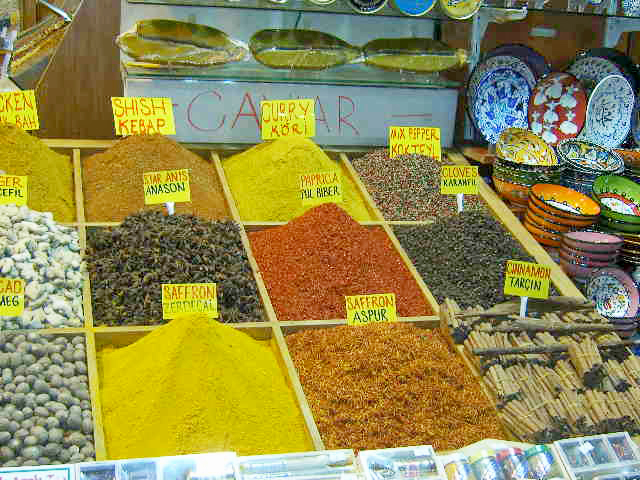
By Candace H. Chemtob, MS, RD, LD, CSSD
The right spices can make the difference between a bland dish and something sublime. In the culinary world, spices are the “tools of the trade” that can divide the average from the celebrity chef. While the demand for the perfect spice may seem relatively unimportant today, one only has to look to the past to see that the quest of spice changed our world. In fact, the history of the spice trade is almost as fascinating as their flavors are tantalizing.
In the ancient world, spices were used not only to enhance the flavor of food, but also for food preservation and as medicine. Ancient Egyptians were known to feed “exotic” Asian spices to laborers building the pyramids as a source of strength. Herbs and spices have been the foundation of traditional Chinese medicine for thousands of years. Today, modern scientists are trying to unlock the mystery of spices to identify the active ingredients and to study the claims of health benefits. In this article, we will examine a handful of spices in the spotlight.
Chili Peppers, Jalapenos, and Habaneros: While these hot peppers can deliver a big “punch” to your palate, their active ingredient may help relieve tired and sore muscles and joints. Capsaicin, the active ingredient in hot peppers, is a skin irritant. When applied topically, capsaicin stimulates nerve cells. Eventually, the nerve cells “fatigue” and are “no longer responsive to a broad range of stimuli” causing the sensation of minor pain to subside. Temporary relief from pain may be achieved, but this is not a “cure” for the underlying cause of pain. Capsaicin is a “natural” pain reliever but has reported side effects and should only be used under physician supervision (www.ncbi.nlm.nih.gov).
Cinnamon: The history of cinnamon dates back thousands of years. In the ancient world, cinnamon was used not only to flavor food, but also as a perfume and food preservative. “Cinnamon has a long history of use as a folk or traditional medicine…for bronchitis, gastrointestinal problems, loss of appetite, and control of diabetes” (NIH, National Center for Complimentary and Integrative Health). Control of diabetes has been substantiated by the USDA. “Our studies have demonstrated that extracts of cinnamon increase insulin activity several-fold…improved insulin function leads to improved blood sugar concentrations” (Hormone Research, vol. 50, pages 177-182, 1998 and Journal of the American College of Nutrition, vol. 20, pages 327-336, 2001). The USDA suggests one half teaspoon of cinnamon (dry, not oil form) leads to improvements in blood sugar, cholesterol, LDL-cholesterol, and triglycerides and at these levels it is safe and without side effects (USDA, doc 8877).
Ginger: Confucius advocated the use of ginger in the 6th Century BC. Traditionally, ginger has been used as a digestive aid and to prevent nausea. Recent research has confirmed the anti-nausea benefits of ginger and that it can reduce the symptoms of “morning sickness” during pregnancy. Used in small doses, there are few reported side effects. Research is underway on the benefits of ginger on joint inflammation and rheumatoid arthritis.
Salt (Sodium Chloride): While technically salt is a mineral and not a spice, it is used liberally to enhance the flavor of foods. Salt is the primary source of sodium in the diet. It is common knowledge that Americans consume too much sodium, which is taking a toll on the health of millions. But did you know that inhaling salt particles may be good for your health? Recently, there has been interest in “halo therapy” which is inhalation of salt particles in a controlled chamber. Halo therapy is based on Europe’s natural “salt caves” that have been used for decades to relieve various chest conditions. While still considered experimental, recent research has been promising and halo therapy is currently being used in patients with lung disease (Cystic Fibrosis) and may someday be used may someday be used as an adjunctive therapy for other respiratory conditions. (Int J Chron Obstruct Pulmon Dis. 2014; 9: 239–246; NEJM 2006; 354:229-240).
Tumeric: Tumeric is a shrub related to ginger and grows in India and parts of Asia and Africa, and is an ingredient in curries. It has a distinctive yellow color and has also been used as a natural fabric dye. Traditional Chinese and Indian medicine have used tumeric to aid digestion and liver function, relieve pain, and to heal eczema. A chemical found in turmeric—curcumin—has been studied in animals. Preliminary research indicates that curcumin may have health promoting benefits such as anti-cancer, anti-inflammatory, and antioxidant properties, but “this has not been confirmed in people” (NIH, National Center for Complimentary and Integrative Health). The NIH has funded research to examine these findings in humans.
Add some spice to your life! What was once considered a delicacy, sometimes costing more than gold, spices from around the world are within easy reach. Explore new flavors, not usually found in the American diet, like cardamom, cumin, fenugreek or sumac. Spices will not only increase the enjoyment of eating, but may prove to have inherent benefits to your health.





